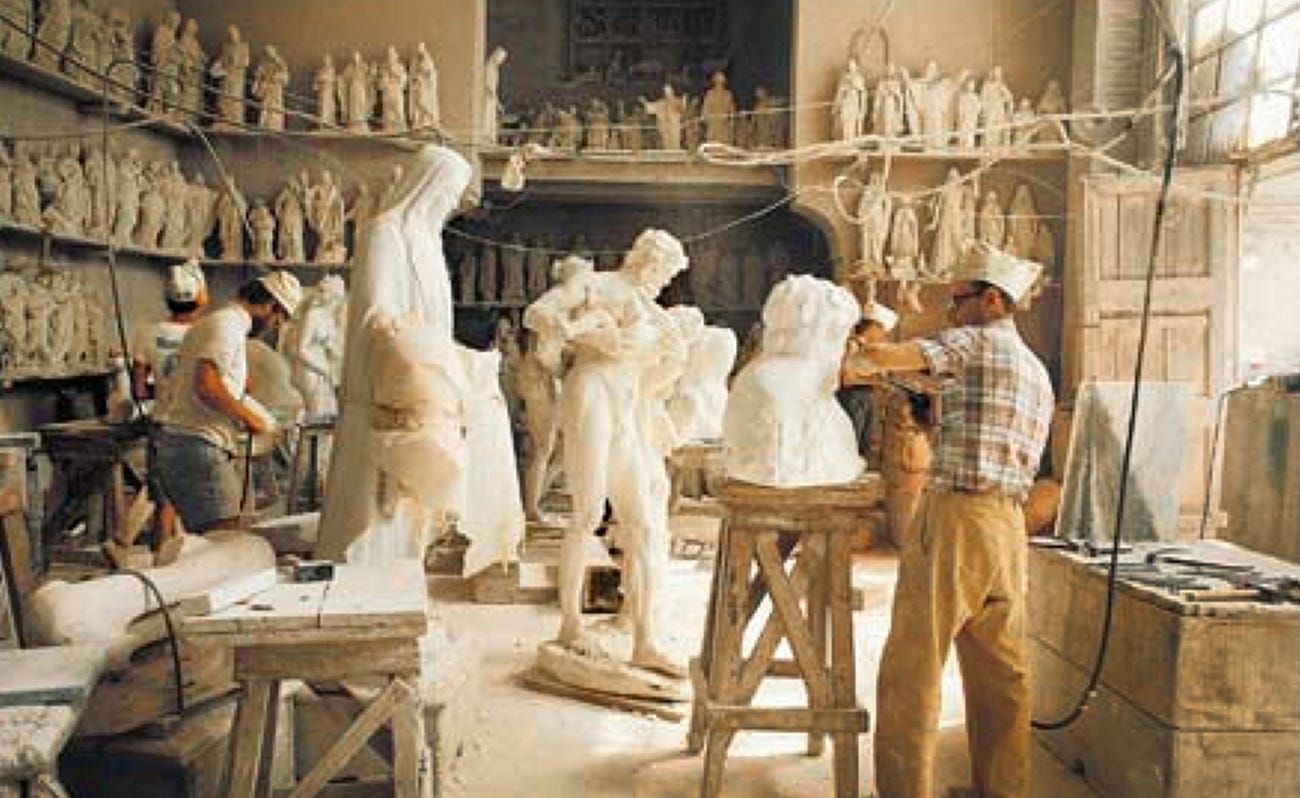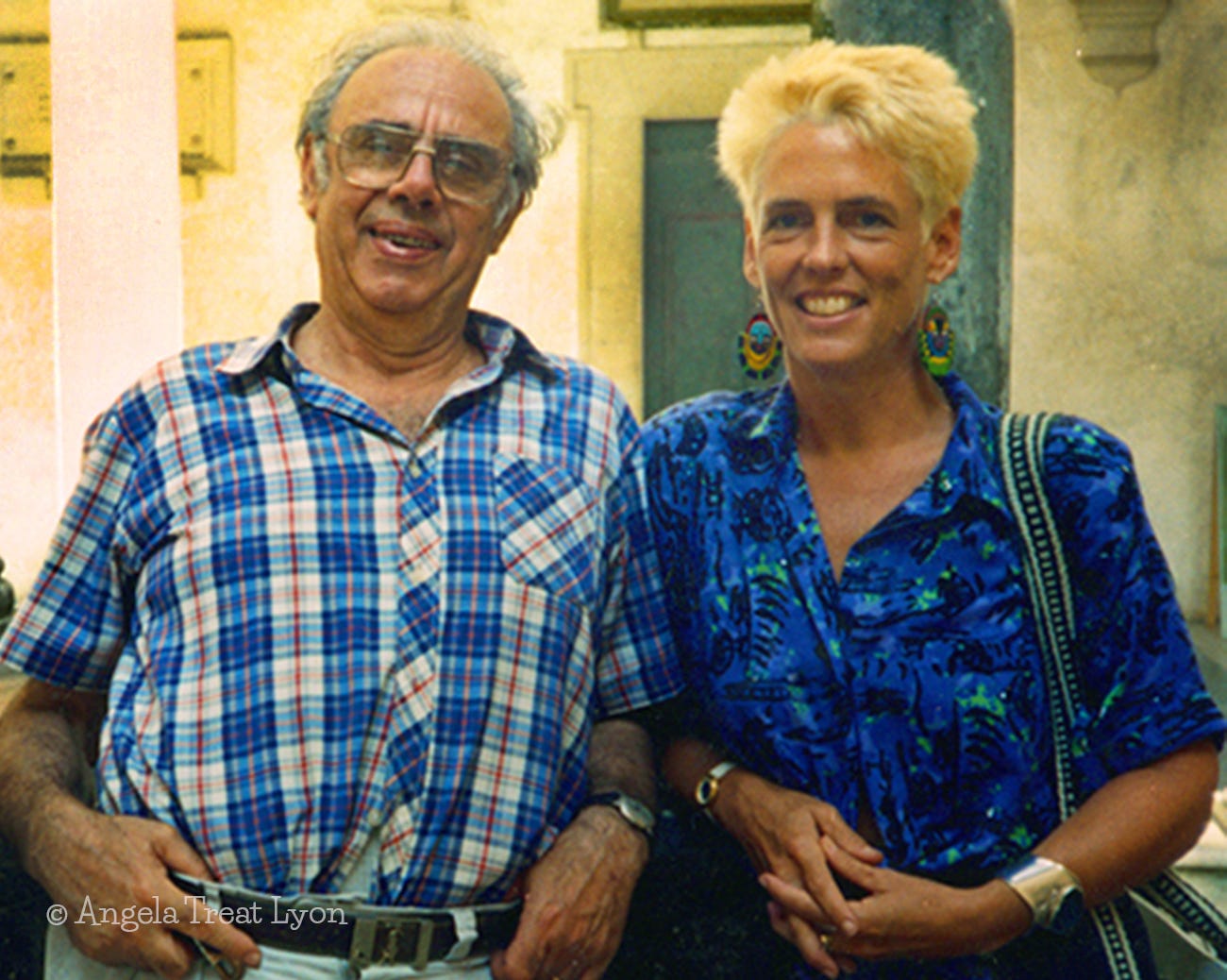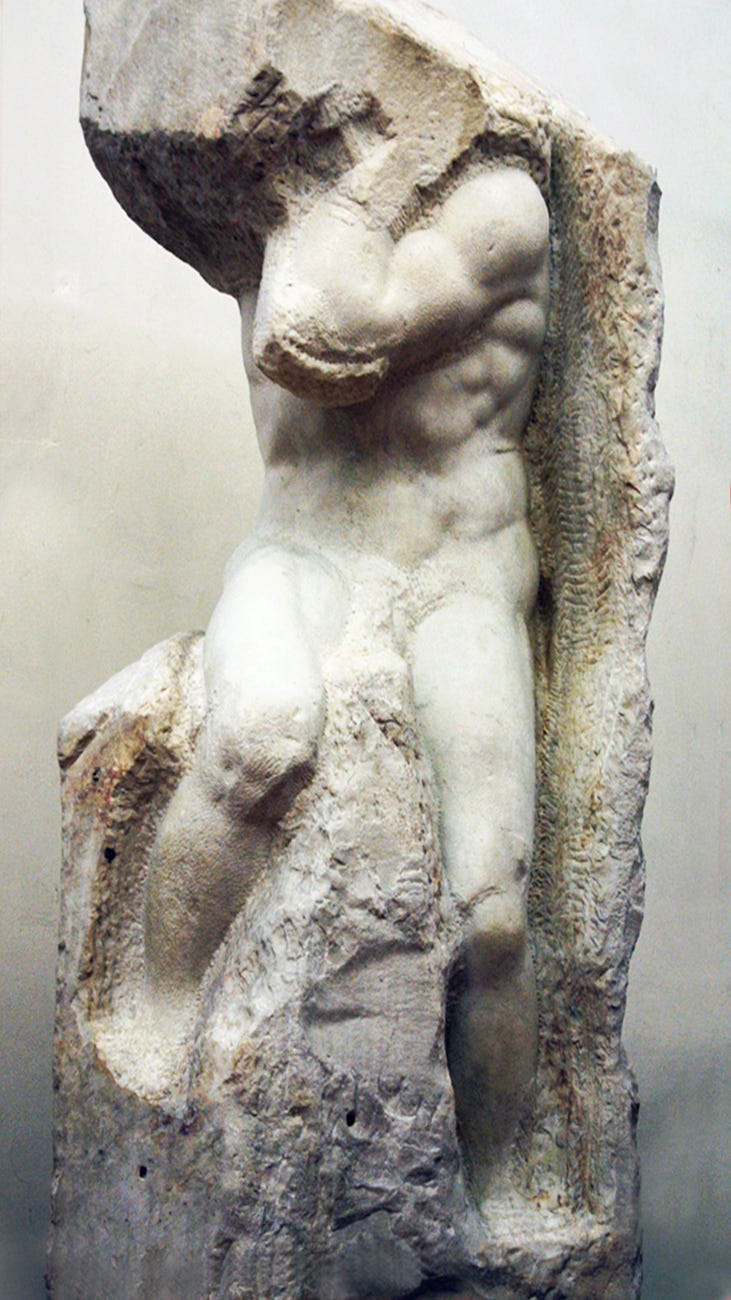
The Maestros’ Carving Studio
I loved hanging out with the master carvers. They were there from before-god-gets-up early until 5pm, when they promptly took off their newspaper hats and scuttled home. They were incredibly skilled, and so fast! They spent most of their time carving replicas of famous works, like the David, and on enormous commissioned pieces and public works.
Our classes were held in the yard of an art school in Lucca, with field trips to a quarry and a couple other studios in Pietra Santa.
The first time we day-tripped up to see studios in Pietra Santa, I got to meet Mario Tomasi, one of the top carvers in Pietra Santa, which is like the marble carving capital of Italy.

Sculptor Mario Tomasi and Me
He had a studio as big as a ten-room house, stuffed to the gills full of sculpture both he and his father had done. There were pieces that dated all the way back from WWII — even a gigantic one of Mussolini that never got finished because the war ended first. He was a horny old dude who, after our tour was over, pulled me aside and tried to convince me to ‘take a nap’ with him — hah! I don’t think so!
At the time, I was living in Hawaii, and folks were gobsmacked that anyone would leave paradise to come carve stone in Italy. Some of the people who asked me where I was from didn’t believe me — they thought Hawaii was just a made-up, unattainable dream. I actually had to pull out my drivers license to show them!
I was so lucky. Those master carvers took me under their wing and showed me stuff I’m betting most carving students never saw. It was like being their American pet. We went to different studios in town where they introduced me to and had fabulous long dinners with the studio heads; they showed me their own personal works; and demonstrated how to hold and use all the tools — from big bread-cutter-looking machines that cut slices of stone meant for countertops, all the way down to the wee bitty tools that could carve a lion’s tail less than 1/8″ thick.
They and Roberto patiently taught me how to use the air tools, myself — how to choose which one to use, how to hold them so I didn’t massacre myself into a bloody mess, how to carve with them. I had avoided power tools because they’re so fast and — well — scary-power-full.
One really old guy showed me the tools they used in the old days before power tools to drill holes. It took two men using a pulley system — one to direct the hole-making bit, the other to pull the string-pulley mechanism back and forth. Hard to explain –
I bet you don’t know what an air hammer looks like! They’re not at all like the conventional hammer with handle and metal head that you bang on stuff with!
They’re just heavy-duty, hand-size metal tubes that have a piston inside. The piston closes off one end if it is dormant, and if it’s hooked up with air and in the right position, the opening lets air through and makes the piston go back and forth within the tube.
You stick the end of your chisel into the tube, press it against the piston, and voila — the back and forth of the piston makes the chisel vibrate like a jack hammer, so then you can place it against the stone to chip off small pieces.

Carver using an air hammer and chisel
The master carvers wore folded-newspaper hats — they said it was to keep the marble dust from slicing their hair, but — erm — there were still plenty of bald heads! Those hats were actually only worn by the old-timers, and were prized symbols of years of developed skill and expertise.
They laughed and had great fun teasing me for having carved for almost ten years using only hand tools — hammer and chisel and rasps, but no power. They couldn’t understand why anyone wanted to be so slow.

Pretending to be another sculpture…
But my impetus has never come from wanting or having to carve big commissioned pieces, or replicas of famous works. It comes from ‘what can I carve that would reflect my heart and life values?’ I have no need for more speed or excess power than I possess in my own hands and body.
I think it was a good move, carving by hand all those years, getting the feel for and the knowledge of stone and its nature embedded deeply into my cells, instead of jumping into using power tools right off. I got to see and feel and carve a huge variety of stone in a wide variety of color, weight, texture and hardness.
I liked taking it slow, carefully training myself step by step in a steady, plodding pace. As a result, I got to the point where I can just look at a stone, or even a finished sculpture, and know how it would feel in my hands. How the grain runs, how brittle or strong it is, how it would carve, how it would look polished. It was a fantastic foundation to build upon.
I still find carving with power tools scary as all hell — right along with such a rush that even now, many years later, I can hardly breathe when I do it.
Scary, because it’s such a rush — because — power! I made sure I learned to use both electric and air tools really well. By far the most scary are the big electric saws with their enormous round whirling diamond-edged blades. You have to be super careful not to take off fingers or toes.
They’re heavy, and it’s way too easy to get tired. Sustained holding the weight of the saws as they blast through the stone is a real chore — clouds of dust swirling around you, sticking to your safety glasses, obscuring your full vision — you’re in constant danger of slipping and ripping your thigh apart or dropping it onto your feet with the falling blade. Respect for your tool is a must.
Scary, because it’s so easy to run rampant wreckage right through the stone, whacking a piece off that you didn’t want to remove, or destroying a curve or a nose or a supporting piece that holds the whole thing up.
When that happens, now you have to either ditch the unsave-able piece, or re-imagine the design, and adjust the rest of it to fit your altered plan.

PEACE — the bronze made from the stone original. 16 x12x12
See how the head of Peace is tilted to the side? I roughed out the whole piece, then started carving her head. I had originally planned on her head being straight up, not tilted.
When I got to the tip of her ear, the entire top of her head blasted right off! I had hit a hidden pebble in the stone, and it created a reverberation that shocked that part of the stone into flying off.
I didn’t know what to do, so I put her on a shelf in the back of my studio. About a month later, I had a dream where she looked like this. There was just enough stone to do it.
Some carvers start by looking at the stone itself to see and feel what the stone is ‘telling’ them.
Trying to ‘see’ what’s inside a stone that’s been cut into a block, trying to source the design or image inside a cut, squared-off block of stone, is really hard, because all you see is sharp angles and corners. Unless you like working with flat planes and angles, there’s no Dream connection to show you what’s in the stone.
You also have to carefully search for cracks and fissures, and either cut away that part of the stone, or work around them. If you leave a fissure, you better make sure it doesn’t go all the way through the stone, because a sharp shock will end up with your piece falling apart on you like what happened with Peace.
There may be deposits of mud, inclusions of harder stone, pockets of soft stone, holes, or other weird things. If you know those things are there, you can eliminate them or work around them. If you don’t find them before you start, it can be a nasty surprise to start carving a nose and find a crack or a hole there, or a hunk of dried mud!
With a naturally-shaped chunk of stone, it’s easier to perceive shapes, critters, people, etc., within the stone. Some carvers, like me, ‘see’ a piece as it might be when it is carved and done. Then we proceed to implement that vision. Sometimes I sketch out my idea, but it’s always really sparse.

Drawing for Eternity sculpture
First, I draw the main action lines of a piece with a red crayon. If it’s a human or a critter, I draw the primary movement of the spine, because that’s the most basic line in the whole body, and the rest of the body will fall into place if you have the spine right.

The beginning
Then, I make the initial cuts with a big saw or coarse grinder. I knock off the majority of the unwanted material with hammer and a big, wide, flat cold chisel.
Next I refine with 3 and 5-toothed chisels that look like cut-off pieces of a comb, then flat-faced ones. I use smaller and smaller chisels until I get to a point where I can use rasps, and then rifflers — tiny-toothed rasps. Lastly, sandpaper.
If you ever get the chance, make sure to go to Florence, Italy, and spend time gawking at Michelangelo’s Unfinished Slaves at the Academia Gallery in Florence. They are amazing examples of the progression of steps a carver takes start to finish. You can see every tool mark, every choice he made.

One of the Unfinished Slaves by Michelangelo
A friend and I had the entire Academia to ourselves because we visited right after lunch hour. When we got to the street where the Academia was, there was an enormous frothing crowd of people streaming away from the museum. They filled the street to the point we had to duck into a doorway to keep from being swept along.
When we finally were able to enter the museum, the guard was surprised we weren’t part of that group. He was delighted to be able to give us a magnificent detailed tour.
It was during the time when most cameras still used film, and he sternly reminded us there was no photography using flashes. I didn’t know this, but the light from the flashes erode the color in the paintings! Luckily, the slaves and the David were very well-lit, so I didn’t need extra lighting.
I took particular delight in seeing if it was true what I’d heard: the David’s left pinky toe wasn’t fully formed, due to Michelangelo’s not figuring the foot out before he started carving. Yup — true!

The poor mangled left-foot toe on the David
When we returned to Lucca, both my buddy and I were so inspired and excited to get back to carving again, even though we had to work from maquettes.
Roberto made us create small clay model-mockups to carve by, because that was the process he’d learned and used.
It was virtually the only time I have ever made one. I hated it, but I had a crush on him and wanted to humor him, so I tried it anyway. I pretended to let it guide me as I carved the piece I was working on.
Stone looks awesome all shiny and smooth when it’s polished up. But if we polished the surface down to 1500 or 1800 grit shiny-smoothness on the parts of the figures where skin was portrayed, it brings out the ‘figure’ of the stone, but the surface looks fake, like shiny plastic.
You can see how it looks here in Hula Kahiko (Ancient Hula). See how shiny she is? Doesn’t look like skin.

Hula Kahiko — California Steatite — 24x16x4
Roberto showed us how to make the skin look satiny, even a bit rough, more like real skin. So now when I carve humans, I only take my sandpaper grit down to 360, if that. See how soft Yule Mama looks? That’s why. I carved her from the sugary-crystal marble from Yule, Colorado.

Yule Mama – detail – Yule Marble, 9x12x6
Shiny works better for abstract and geometric pieces, where the shiny facets can be perceived as part of the design.
Continued in STONE CARVER, Part IV
-=-=-=-=-=-=-=-=-=-=-=-=-=-
text and indicated images © Angela Treat Lyon 2023
Originals and prints: https://LyonArtandDesign.com
Sculpture: https://AngelaTreatLyonART.com
Recent tile designs here: https://instagram.com/angela.treat.lyon
I invite you to be part of my art group:
https://facebook.com/groups/AngelaTreatLyonART
More about my carving adventures: Carving My Life: Volume I
https://amzn.to/3LuhRgU
Read this story on Medium:
https://medium.com/@lyonlyon/stone-carver-part-iii-a26a32becfcf
Inspiring Pandemic Story
https://medium.com/@lyonlyon/make-art-not-worry-432865649689
